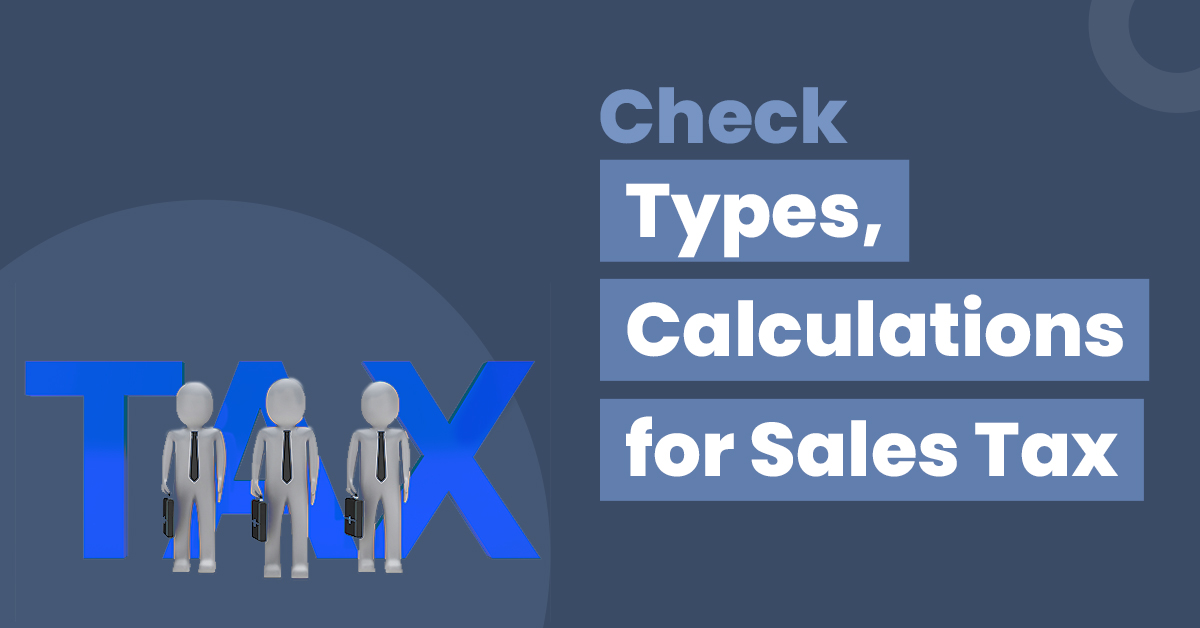GST (Sales Tax in India): Meaning, Types, Calculation and Other Details


Taxes are the sources of revenue for every government. Several kinds of taxes are imposed on common civilians for varied purposes. However, broadly there are two types of taxes in India, direct and indirect. In this article, you will know about an indirect tax: Goods and Service Tax (GST) in India. Keep scrolling to know more about it.
What is GST?
Earlier in India, different kinds of sales tax were imposed on purchasing goods. However, on 1st July 2017, the Goods and Service Tax Act came into action and replaced all other types of sales taxes for both central and state governments.
Goods and Service Tax (GST) is an indirect tax imposed on supply of goods and services for domestic consumption. Consumers pay GST on the final price of a product. As the consumers pay GST, the sellers collect it and send it to the government.
What Are the Types of GST?
GST is further classified into 4 types. Check out the detailed discussion on them.
State Goods and Service Tax (SGST)
As the name suggests, State Goods and Service Tax (SGST), is collected by the state government and is applicable for intra-state transactions. Therefore, this GST has a geographical boundary. SGST is applied to every good; however, alcoholic liquor does not come under SGST. Though every individual state has some policies to collect SGST, the internal structure remains the same.
Central Goods and Service Tax (CGST)
CGST is the tax imposed by the central government on intra-state goods and services. CGST has replaced all other types of taxes that were applicable earlier. Therefore, products within a state’s periphery are subject to two types of taxes, SGST and CGST. As the sellers collect the tax, they send the percentage to the two governments accordingly.ST is the tax imposed by the central government on intra-state goods and services. CGST has replaced all other types of taxes that were applicable earlier. Therefore, products within a state’s periphery are subject to two types of taxes, SGST and CGST. As the sellers collect the tax, they send the percentage to the two governments accordingly.
Integrated Goods and Services Tax or (IGST)
This tax is levied on the inter-state transactions of goods and services. Let’s understand it with an example. Suppose a seller from Delhi sells goods to a dealer in Odisha. Therefore, the transaction happens between two states, and IGST will be applicable in this case. IGST is first collected by the central government, and the state’s percentage is later given to the respective states.
Union Territory Goods and Service Tax or UTGST
The taxes are applicable to the transaction in Union Territories such as Andaman and Nicobar Island, Daman and Diu, Lakshadweep, Chandigarh, Dadra and Nagar Haveli. The percentage of SGST and UTGST is similar. Further, there is no legislation applicable to UTGST.
What Are the Objectives of GST?
The objectives of GST are as follows:
- One Nation, One Tax
There were different kinds of taxes levied on goods and services as indirect taxes. States and central governments had different tax percentages, and the rules regarding these were pretty complex. However, GST has replaced all these taxes and made the ideology of “One Nation, One Tax” applicable to India.
- To Replace a Majority of Indirect Taxes in India
Before GST came, multiple taxes were applied to manufacturing and selling goods, such as excise duty, value added tax or VAT, service tax etc. Both central and state governments governed these taxes, and there was a lack of unified laws regarding tax collection. Therefore, the objective of GST was to merge major types of indirect taxes and make the process of law creation and tax collection easy. So, tax cascading has also been eliminated.
- To Control Tax Evasion
Another objective of GST was to curb tax evasion by enacting strict laws. Previously, laws on every indirect tax were not very strict; however, GST demands submitting proper invoices. This has made the tax-paying process fairer. Besides, it has also introduced a proper surveillance system.
- To Improve Distribution and Logistics
GST came to eliminate all the hassles regarding documentation of paying several taxes for manufacturing and selling goods. As a result, it improved the transportation cycle times and supply chain turnaround time. Besides, GST has an e-way bill system which helps in minimising higher warehousing and logistic costs.
How to Calculate GST?
GST calculation has several kinds of charges included, which are:
- Reverse charge
- Exempted supplies
- Eligible and non-eligible ITC
- Inter-state sales
Calculating GST correctly is very important as it removes the chances of an 18% penalty for not paying the right amount as your obligation. Therefore, the formula for GST calculation is as follows:
GST Amount = (Original Price X GST Rate)/100
Net Price = Original Price + GST Amount
Let’s understand it with an example. A manufacturer sells a good worth Rs. 15,000, with a GST rate of 12%. Therefore, the GST Amount payable will be
(15000X12)/100 = 1800
And the net price of that good will be (15000+1800)= Rs. 16,800
How to Do GST Registration?
The stepwise guide for GST registration is as follows:
Step 1: Visit official portal for GST
Step 2: Verify OTP and generate TRN
Step 3: Log in with TRN
Step 4: Submit all the necessary business information
Step 5: On the next tab, provide promoter’s information
Step 6: Provide authorised signatory information
Step 7: Provide the address of the principal and additional place of business
Step 8: Submit the details of goods and services
Step 9: Provide bank account details
Step 10: Verify your application
Step 11: Generate ARN number and use it to track your application status
What Is the GST Login Process for Existing Users?
The users who have already registered under GST portal can log in by following the below-mentioned steps:
Step 1: Go to official GST portal
Step 2: Find login button on the right-hand corner of the homepage and click on it
Step 3: Input your username and password and fill in CAPTCHA
You will be logged in to the portal and get the tabs like pay returns tab, file returns tab, Annual Aggregate Turnover etc.
What Are the GST Rate Slabs?
Based on the types, almost 500 services and 1300 goods are categorised under 4 GST rate slabs. These slabs are 5%, 12%, 18% and 28%. However, gold has a different GST rate of 3%. In addition, rough and semi-precious stones fall under a tax slab of 0.25%.
What Is GSTR and When to File GSTR?
GSTR stands for GST returns, which is an official proof of an entity’s tax liability. The components of GSTR are:
- Purchase
- Sales
- Output GST
- Input Tax Credit
- Bank Account Details
As per the law, business owners with an aggregate turnover of Rs. 5 crores have to file 2 monthly and 1 annual GSTR. The chart of GSTR is as follows:
| Return Form and Frequency | Due Date |
| GSTR-1 (Monthly) | 11th of next month, with effect from October 2018 |
| GSTR-3B (Monthly) | 20th of next month |
| GSTR-4 (Quarterly) | 18th of the month of the quarter |
| GSTR-5 (Monthly) | 20th of next month |
| GSTR-6 (Monthly) | 13th of next month |
| GSTR-7 (Monthly) | 10th of next month |
| GSTR-8 (Monthly) | 10th of next month |
| GSTR-9 (Annually) | 31st December of the next financial year |
Advantages of GST
The benefits of GST are:
- It brings a unified tax structure
- It increases the logistic efficiency
- It promotes the increase of consumption and competitive pricing
- It benefits small businesses by introducing composition schemes
- It inputs laws for unorganised sectors
Final Word
We hope that this guide has given you a comprehensive idea about the GST in India. The tax is completely governed and benefits taxpayers, the government and the economy of the nation in several ways.
This article also explains the steps of GST calculation and the types of it, so that you can get a clear idea on how to calculate the tax payable and why you pay it.
Frequently Asked Questions
On which services are GST not applicable?
GST does not apply to these following services:
Electricity
Salary and wages
Interest
Government fees, for example, land registration and MCA fees
What are the types of GST registration?
There are 4 types of GST registration based on the types of taxpayers. These are:
Normal Taxpayer: Business owners who conduct business in India.
Composition Taxpayer: Taxpayers who are under GST composition scheme.
Casual Taxable Person: Taxpayers who conduct seasonal business.
Non-Resident Taxable Person: Business owners who reside outside of India and supply taxable goods to India.
Which documents does a sole proprietor or individual need to submit for GST registration?
The documents that a sole proprietor or individual needs to submit for GST registration are:
Address proof
PAN
Aadhaar card of owner
Bank account details of owner
Photograph of owner
What are the new compliances under GST?
Some new systems added under GST are:
E-way bills: With these, e-way bills for transported goods can be generated easily.
E-invoicing: It reduces errors while entering data and makes the process of submitting invoices fast.
HSN code requirements: The introduction of HSN and SAC codes has simplified the process of understanding tax slabs for goods and services.
What are the eligibility criteria for GST registration?
There are 5 eligibility criteria for GST registration. These are:
Aggregate turnover- Businesses with more than Rs. 20 lakh (Rs. 40 lakh for a supplier) aggregate in a year
E-commerce platform- Businesses conducted on e-commerce platforms
Inter-state business- Business that supplies goods inter-state
Casual taxable persons- Temporary businesses
Voluntary registration- Voluntary registration for GST of any entity



